Related Research Articles

Swansea is a coastal city and the second-largest city of Wales. It forms a principal area, officially known as the City and County of Swansea.

The Swansea and Mumbles Railway was the venue for the world's first passenger horsecar railway service, located in Swansea, Wales, United Kingdom.
The Afan Forest Park is a 48-square-mile (120 km2) forest park in Britain. It is set in the Afan Valley in Neath Port Talbot, in south Wales. It is well known for its mountain biking and hiking or hillwalking trails. It is situated seven miles (11 km) from Junction 40 of the M4.
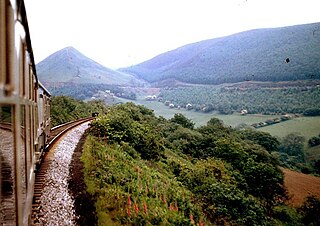
The Heart of Wales line is a railway line running from Craven Arms in Shropshire to Llanelli in southwest Wales. It serves a number of rural centres, including the nineteenth-century spa towns Llandrindod Wells, Llangammarch Wells and Llanwrtyd Wells. At Builth Road, two miles (3.3 km) from the town of Builth Wells, the line crosses the former route of the earlier Mid Wales Railway, which closed in the 1960s.
Dunvant is a suburban district and community (parish) in the City and County of Swansea, Wales, and falls within the Dunvant ward. It is situated in a valley some 4.5 miles west of Swansea city centre. The population as of the 2011 census was 4,383. It adjoins the area of Killay.
Blackpill is a suburban area of Swansea, Wales, beside Swansea Bay, about 3 miles (4.8 km) southwest of the city centre.
Waunarlwydd is a village and community in Swansea, Wales, within the newly formed Waunarlwydd ward in 2021. Wendy Lewis Labour is the first elected councillor for the newly created ward which she comfortably won in the 2022 local elections. In 2022 Waunarlwydd became a community.
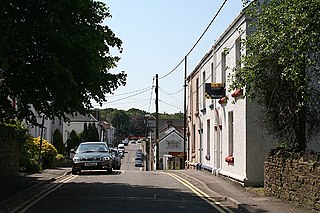
Gowerton is a large village and community, about 4 miles north west of Swansea city centre, Wales. Gowerton is often known as the gateway to the Gower Peninsula. Gowerton's original name was Ffosfelin. The village falls within the Gowerton electoral ward of the City and County of Swansea Council, which elects one councillor. The community had a population of 5,212. and the built-up area with Waunarlwydd 8,183.
Killay is the name of a suburb and local government community in Swansea, Wales. Killay has its own community council. The village is set high above sea level, about 3.5 miles (5.6 km) west of Swansea city centre. It adjoins the town of Dunvant and the Tycoch area of Swansea. Gowerton lies to the north. The community had a population of 5,702 in 2011.
Mayals is a suburb of Swansea, Wales. It is located about 3 miles south west of Swansea city centre. It falls within the Mayals ward and the Mumbles community council area (MCC). The ward of Mayals lies within the constituency of Swansea West, the only MCC ward not in the Gower constituency.
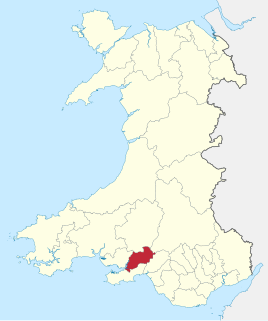
The Borough of Lliw Valley was one of the four local government districts of West Glamorgan, Wales from 1974 to 1996. It was formed by the merger of the Llwchwr urban district and Pontardawe Rural District, under the Local Government Act 1972.
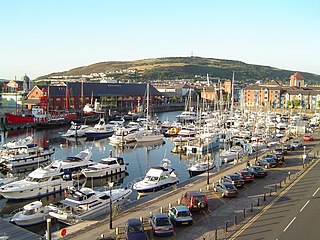
Kilvey Hill is a hill in South Wales, to the east of Swansea. Kilvey Hill is 193 metres (633 ft) high and is classed as a Sub Marilyn. The top of Kilvey Hill enjoys panoramic views of Swansea city centre, Swansea Docks, Swansea Bay, the Lower Swansea Valley, Bon-y-maen, Neath and Port Talbot. Cilfái was a commote of Gower. The historic name of the hill in Welsh is Y Bigwrn, with its summit known as Pen y Bigwrn. Currently, however, it is generally known in Welsh as Mynydd Cilfái, a translation of the English name.

Clyne Castle is a Grade II*-listed building situated on a hill overlooking Swansea Bay, adjacent to the Clyne valley, near Blackpill, Swansea. Originally built in 1791 by a wealthy landowner it passed into the hands of the Vivian family and saw many distinguished guests over the years. Acquired by Swansea University in the 1950s, it was used as student accommodation. It has since become a block of luxury apartments.
National Cycle Route 4 is a route of the National Cycle Network, running from London to Fishguard, Pembrokeshire. Between these, the route runs through Reading, Bath, Bristol, Newport, Swansea and St David's. Within Wales, sections of the route follow branches of the Celtic Trail cycle route.

Clyne Gardens is a botanical garden located in Swansea, Wales, UK. The current park was formed from the landscaped gardens created by Glynn Vivian of the Vivian family who purchased Clyne Castle in 1860. The estate passed to his nephew Algernon, 'The Admiral' in 1921 who owned it until his death in 1952. He had the greatest influence on the gardens as we see them today. Clyne Gardens is bordered by Mumbles road and Mayals road in Blackpill and Mayals areas of Swansea with entrances off both these roads.
Swansea Beach stretches for five miles along Swansea Bay between the Maritime Quarter and the "Knab Rock" near Mumbles in Wales. It is backed by a promenade/cycle track and a coastal road. The southern section of the Swansea Bay beach between Blackpill and Mumbles is designated Site of Special Scientific Interest.

The Clyne River is a river in Swansea, south Wales. It has a total length of 6.5 miles (10.5 km), and flows through the Clyne Valley Country Park for much of its length.
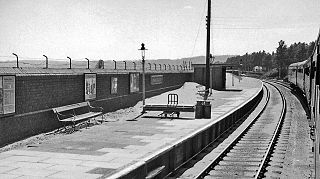
Swansea Bay is a former railway station in Swansea next to Swansea Bay, in South Wales, opened to passenger and goods traffic on 14 December 1867. Owned successively by the Llanelly Railway and Dock Company, the Swansea and Carmarthen Railways Company, the London and North Western Railway Company, the London, Midland and Scottish Railway Company and British Railways, it was served by trains to and from Shrewsbury, Crewe, Liverpool, Manchester and York and formed the southern terminus of the Central Wales line, most of which is still operational as the Heart of Wales Line. Swansea Bay closed in June 1964, having been listed in the Report on the Reshaping of British Railways the previous year. The former station is near Blackpill and the Clyne Valley Country Park and was adjacent to the Swansea and Mumbles Railway which was closed in 1960. Much of the trackbed is now part of the A4067 road towards Swansea Victoria.
References
- ↑ "Clyne Valley Community Project".
- ↑ "Clyne Valley Country Park". City and County of Swansea.
- ↑ "Clyne Riders". Archived from the original on 10 August 2011. Retrieved 27 July 2011.